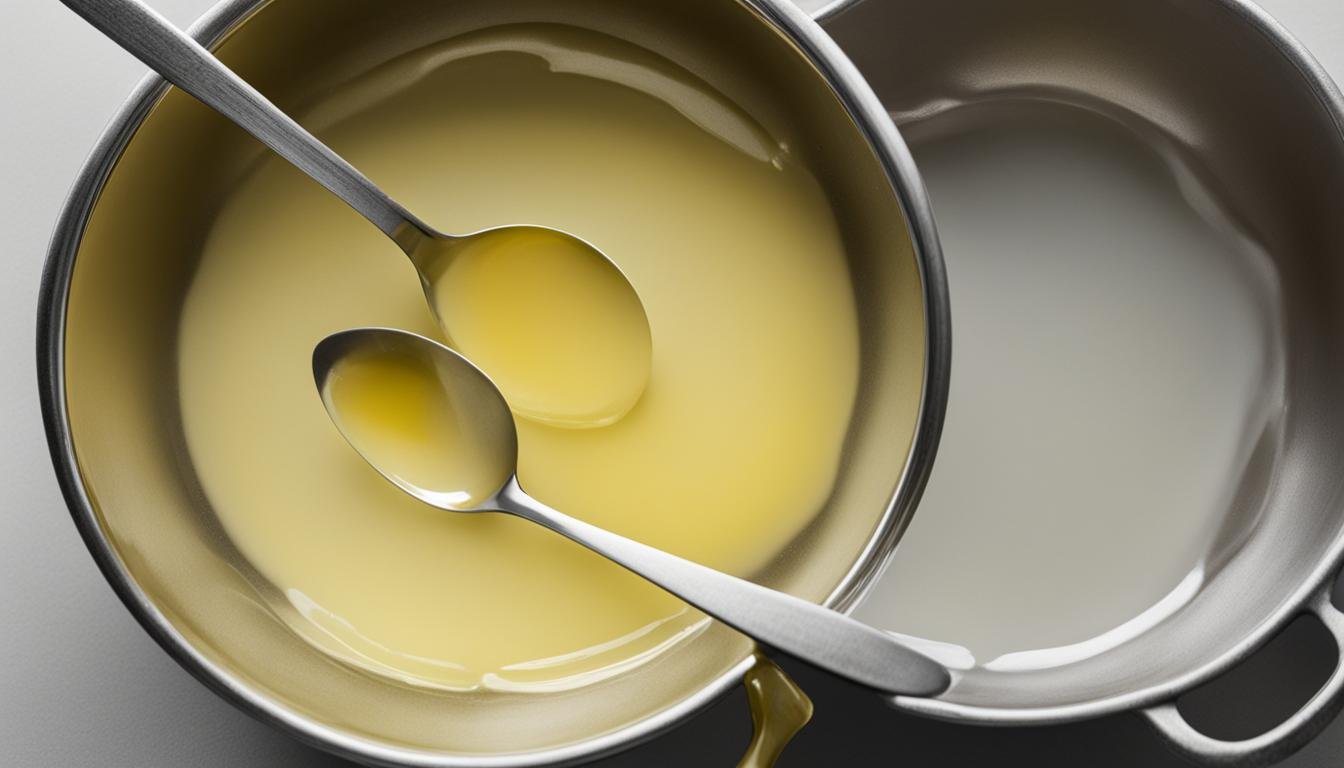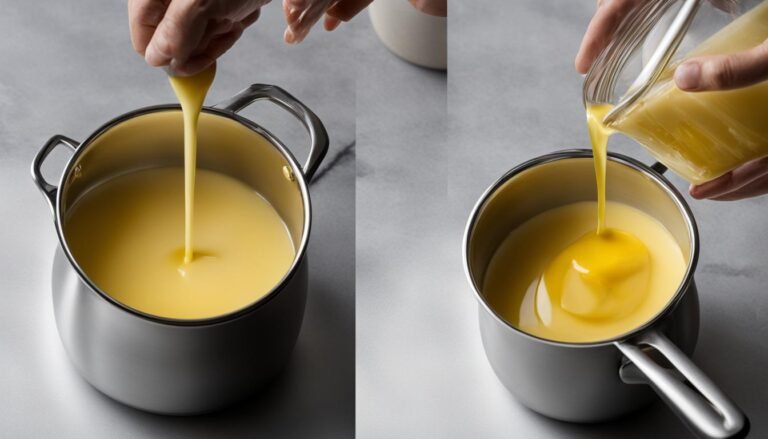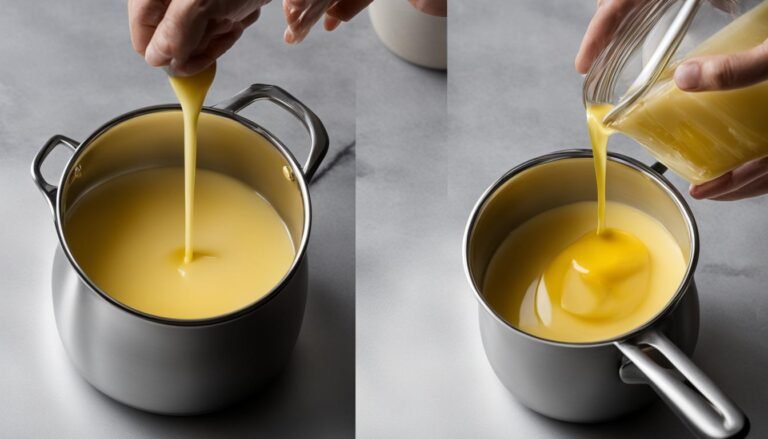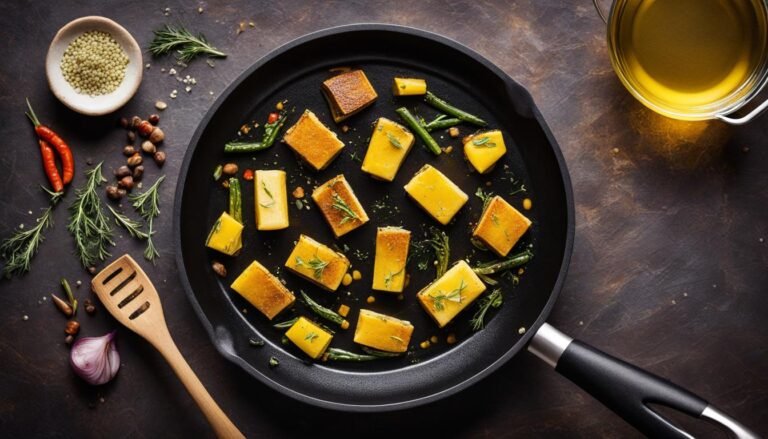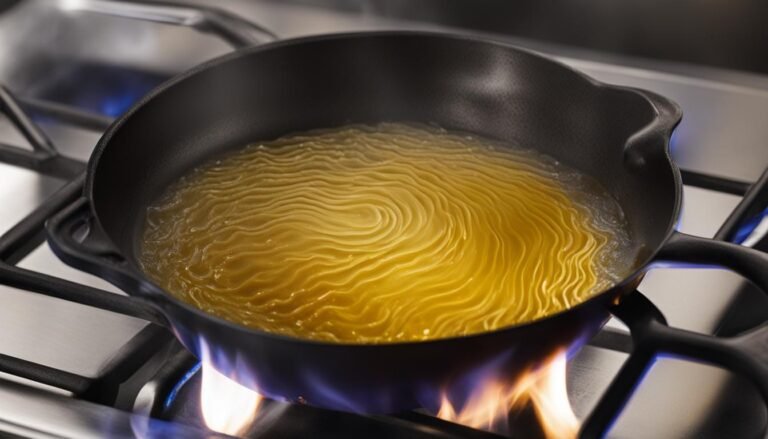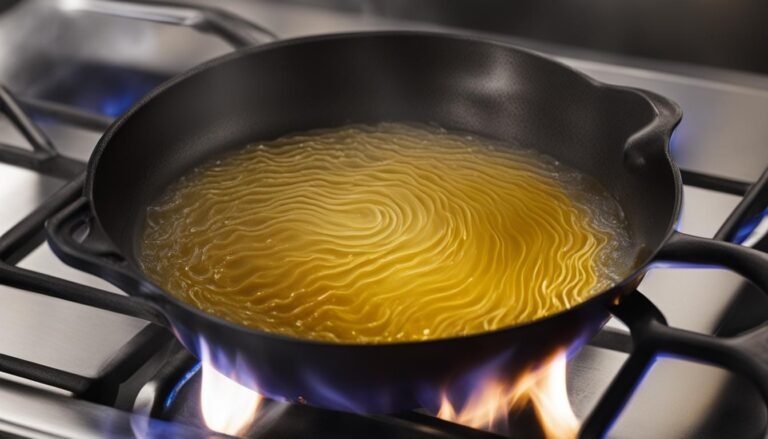Ghee vs Clarified Butter: Differences Explained
Ghee and clarified butter are often used interchangeably in cooking and have similar characteristics, but there are important differences between the two. Understanding these differences is crucial for making informed choices in the kitchen. This article will explore the basics of ghee and clarified butter, their nutritional profiles, taste differences, cooking applications, health benefits, and more. By the end, you’ll have a clear understanding of how ghee and clarified butter differ and when to use each product.
Key Takeaways:
- Ghee and clarified butter are similar but have distinct differences in aroma, taste, and cooking applications.
- Ghee is a form of clarified butter that is cooked longer, giving it a nutty flavor and caramelized milk solids.
- Ghee and clarified butter have similar nutritional profiles, with ghee containing slightly higher levels of conjugated linoleic acid.
- Both ghee and clarified butter have high smoke points, making them suitable for high-heat cooking methods like frying.
- When choosing between ghee and clarified butter, consider personal taste preferences and specific recipe requirements.
Introduction to Ghee and Clarified Butter
Ghee and clarified butter are two important ingredients in cooking that share many similarities, but also have distinct differences. In this section, we will introduce you to the world of ghee and clarified butter, exploring their origins, production processes, and common uses.
Ghee, also known as “liquid gold,” has its roots in Indian cuisine and is widely used in South Asian cooking. It is made by simmering butter for an extended period of time, which allows the milk solids to separate and then be removed, leaving behind pure butterfat. The resulting golden liquid is known as ghee and has a rich, nutty flavor.
Clarified butter, on the other hand, is a more general term used to describe butter that has been heated to separate the milk solids and water. This process removes impurities and extends the shelf life of the butter. While ghee is a form of clarified butter, not all clarified butter is ghee. Clarified butter has a neutral flavor and is commonly used in European cuisine and baking.
Both ghee and clarified butter have a high smoke point, which means they can be heated to high temperatures without burning or producing smoke. This makes them ideal for frying, sautéing, and other high-heat cooking methods. Additionally, both ingredients are free of lactose and casein, making them suitable for individuals with lactose intolerance.
Now that we have introduced ghee and clarified butter, let’s dive deeper into their differences in the upcoming sections.
Ghee vs Clarified Butter: Understanding the Basics
Before diving into the differences, it’s important to have a basic understanding of what clarified butter and ghee actually are.
What Constitutes Clarified Butter?
Clarified butter is made by heating butter and removing the milk solids and water content, leaving behind pure butterfat.
Defining Ghee: The Process and Origin
Ghee is a form of clarified butter that is cooked for a longer period of time, allowing the milk solids to caramelize and impart a nutty flavor.
Similarities Between Ghee and Clarified Butter
Both clarified butter and ghee are free of lactose and casein, making them suitable for those with lactose intolerance or following a paleo diet. Additionally, both products have a high smoke point, making them ideal for high-heat cooking methods like sautéing and frying.
Nutritional Comparison: Ghee vs Clarified Butter Nutrition
While ghee and clarified butter have similar nutritional profiles, there are slight differences to consider. Both are rich in vitamins A, E, and K, as well as saturated and monounsaturated fats. They also contain conjugated linoleic acid (CLA), which has potential health benefits. However, ghee has a slightly higher concentration of CLA due to the longer cooking process. Additionally, ghee is often praised for its potential gut health benefits, as it contains butyric acid and other short-chain fatty acids.
This section will provide a detailed nutritional comparison between ghee and clarified butter, highlighting their similarities and differences.

| Nutrient | Ghee | Clarified Butter |
|---|---|---|
| Vitamin A | High | High |
| Vitamin E | High | High |
| Vitamin K | High | High |
| Saturated Fats | Present | Present |
| Monounsaturated Fats | Present | Present |
| Conjugated Linoleic Acid (CLA) | Higher concentration | Lower concentration |
| Butyric Acid and Short-Chain Fatty Acids | Present | Absent |
Exploring Taste Profiles: Ghee vs Clarified Butter Taste
One of the key differences between ghee and clarified butter is their taste. Ghee has a distinct nutty flavor, thanks to the caramelization of the milk solids during the cooking process. This nuttiness adds depth and richness to dishes, making ghee a popular choice in Indian cuisine.
On the other hand, clarified butter has a more subtle taste, allowing it to blend seamlessly into various culinary applications. Its neutral flavor makes it versatile and ideal for recipes where you want the butter flavor without overpowering other ingredients.
Nutty Differences: How Ghee’s Flavor Stands Out
Ghee’s nutty flavor is a result of the prolonged cooking process that allows the milk solids to caramelize. This enhances the natural sweetness of butter and creates a unique taste profile that’s prized in many cuisines.
“The nutty flavor of ghee beautifully complements sautéed vegetables, rice dishes, and curries, bringing a rich and distinctive taste to the final dish.” – Chef Anjali Kapoor
The nuttiness of ghee can elevate a wide range of recipes, from traditional Indian curries to baked goods like cookies and cakes.
The Subtle Taste of Clarified Butter in Culinary Uses
Unlike ghee, clarified butter has a milder flavor that allows it to adapt to a variety of culinary uses. Its subtlety makes it an excellent choice for applications where you want the buttery taste without overpowering the dish.
Clarified butter is often used in French cuisine, where its delicate flavor allows other ingredients and flavors to shine. It’s also a popular choice for making sauces, as it adds richness without overwhelming the taste of other components.
Whether you prefer the nuttiness of ghee or the subtler taste of clarified butter, both offer distinct flavors that can enhance your dishes in different ways.
High-Heat Cooking: Ghee vs Clarified Butter for Frying
Both ghee and clarified butter have high smoke points, making them excellent choices for high-heat cooking methods like frying. However, due to its longer cooking time and nutty flavor, ghee is often favored in frying applications. Ghee’s unique flavor enhances the taste of fried foods, providing a delicious and authentic touch.
When frying with ghee, the longer cooking time allows the milk solids to caramelize, creating a rich and flavorful result. The nutty undertones of ghee add depth to dishes, making them more enjoyable. Whether you’re frying vegetables, meats, or even doughnuts, using ghee can elevate the flavor and bring a unique twist to your culinary creations.
In comparison, clarified butter offers a more neutral taste. This makes it a versatile option, as it allows the flavors of the ingredients to shine through without overpowering them. Clarified butter’s mild taste is ideal for dishes where you want the natural flavors of the food to be the star.
When using either ghee or clarified butter for frying, it’s important to consider the smoke point. Both fats have higher smoke points than regular butter, which means they can withstand higher temperatures before burning. This makes them ideal for deep-frying, pan-frying, and stir-frying.
For best results when frying, heat your pan or pot to the desired temperature and add the ghee or clarified butter. Allow it to melt and distribute evenly before adding your ingredients. This will help prevent sticking and ensure even cooking. Remember to monitor the heat and adjust accordingly to avoid burning.
Baking Delights: Ghee vs Clarified Butter for Baking
Baking with ghee and clarified butter can offer unique results in terms of texture and flavor. Understanding the differences between the two can help you achieve the desired outcome in your baked goods. While ghee provides a rich and nutty taste, clarified butter offers a neutral flavor that allows other ingredients to shine. This section will explore the advantages of using ghee and clarified butter in baking, highlighting their impact on texture, flavor, and overall baking success. Additionally, it will provide valuable tips and application suggestions for incorporating ghee and clarified butter into various baking recipes.
Which Provides the Best Texture and Flavor for Baked Goods?
Ghee’s distinctive nutty flavor can add depth and enhance the taste of your baked goods. The caramelization of milk solids during the cooking process lends a unique taste to ghee, creating a rich and indulgent experience. On the other hand, clarified butter boasts a more neutral taste, allowing the flavors of other ingredients to take center stage. This versatility makes clarified butter an excellent choice when you want the focus to be on the main flavors of your baked goods.
When deciding between ghee and clarified butter for your baking needs, consider the desired outcome. If you’re looking to infuse your baked goods with a delightful nutty taste, ghee is the way to go. However, if you prefer a neutral flavor that complements and enhances the taste of your ingredients, clarified butter is a perfect choice.
Application Tips in Baking with Ghee and Clarified Butter
To achieve the best results when baking with ghee or clarified butter, consider the following tips:
- For recipes that call for butter, you can substitute an equal amount of ghee or clarified butter. Keep in mind that ghee has a more concentrated flavor, so adjust the quantity according to your taste preferences.
- If using ghee, consider using it in recipes that benefit from its nutty flavor, such as cookies, brownies, and desserts.
- When using clarified butter, it can be a versatile option for various baked goods, including cakes, pastries, bread, and pie crusts.
- Experiment with using both ghee and clarified butter in different recipes to discover your favorite flavor combinations.
Overall, ghee and clarified butter can elevate your baking endeavors by adding unique tastes and textures to your creations. Whether you’re aiming for a rich and nutty profile or a neutral backdrop for other flavors to shine, both ghee and clarified butter have their place in the baking world.
Unpacking Health Benefits: Ghee vs Clarified Butter Health Benefits
Ghee and clarified butter have long been recognized for their potential health benefits. Both of these dairy products contain essential nutrients that contribute to overall well-being. In this section, we will explore the specific health benefits associated with ghee and clarified butter, including their potential effects on gut health, heart health, and inflammation. Additionally, we will discuss any considerations or limitations to keep in mind when incorporating ghee and clarified butter into a healthy lifestyle.
Shelf Life and Storage: Ghee vs Clarified Butter Shelf Life
Ghee and clarified butter have longer shelf lives compared to regular butter, thanks to the removal of milk solids. Proper storage practices are essential for maintaining the freshness of these products and maximizing their usability for an extended period.
Proper Storage Practices for Prolonged Freshness
To ensure the longevity of ghee and clarified butter, follow these guidelines:
- Store ghee and clarified butter in airtight containers to prevent exposure to air and moisture, which can cause rancidity.
- Keep ghee and clarified butter away from direct sunlight and heat sources, as they can accelerate spoilage.
- Store ghee and clarified butter in a cool and dry place, such as a pantry or cupboard.
By following these storage practices, you can extend the shelf life of ghee and clarified butter and maintain their freshness for future use.
Maximizing the Usability of Your Choice
In addition to proper storage, there are a few tips to maximize the usability of ghee and clarified butter:
- Use clean and dry utensils when scooping ghee or clarified butter to prevent contamination.
- Seal the container tightly after each use to minimize air exposure.
- Label the container with the date of purchase or preparation to track the freshness.
- Consider portioning ghee or clarified butter into smaller containers for convenience and to minimize exposure to air.
By implementing these practices, you can ensure that your ghee and clarified butter remain in optimal condition, providing you with quality ingredients for your culinary creations.
Understanding Substitutes and Preference: Which is Healthier Ghee or Clarified Butter?
Ghee and clarified butter are often used interchangeably in recipes, but personal preference and dietary considerations may lead to the preference of one over the other. When deciding between ghee and clarified butter, several factors should be taken into consideration:
- Taste: Ghee has a distinct nutty flavor due to the caramelization of the milk solids, while clarified butter has a more subtle taste that allows other ingredients to shine.
- Nutritional Profile: Both ghee and clarified butter are rich in vitamins A, E, and K, as well as saturated and monounsaturated fats. However, ghee has a slightly higher concentration of conjugated linoleic acid (CLA) due to the longer cooking process.
- Individual Health Goals: Depending on specific health goals, individuals may prefer one over the other. For example, ghee is often praised for its potential gut health benefits due to the presence of butyric acid and other short-chain fatty acids.
If ghee or clarified butter is unavailable or not preferred, there are substitutes that can be used in recipes. Some options include coconut oil, avocado oil, or even regular butter. It’s important to consider the taste and cooking properties of the substitute when making a choice.
Ultimately, the decision between ghee and clarified butter comes down to personal preference, taste, and individual health goals. By understanding the factors that differentiate these two products, individuals can make an informed choice that suits their needs.

Cultural Culinary Staple: Why Do People Eat Ghee Instead of Butter?
Ghee holds immense cultural significance in various cuisines and traditional practices. Understanding why people choose to consume ghee instead of butter provides insight into its popularity and widespread usage. This section explores the cultural significance of ghee, focusing on its role in South Asian cuisine and its importance in Ayurveda.
Cultural Significance of Ghee in South Asian Cuisine
In South Asian cuisine, ghee is more than just a cooking ingredient—it is deeply embedded in the region’s culinary heritage. Ghee is widely used in various traditional dishes, such as Indian curries, biryanis, and sweets. Its rich and nutty flavor adds complexity and depth to these meals, enhancing the overall taste and aroma. Additionally, ghee is often used for deep frying and tempering spices, providing an authentic and distinct South Asian taste.
Ghee’s cultural significance extends beyond its culinary applications. In many South Asian households, ghee is considered a symbol of prosperity and abundance. It is often associated with festive occasions, rituals, and special events, where it holds a central place on the dining table. The use of ghee in celebratory feasts and religious ceremonies adds a traditional touch, connecting generations and preserving cultural practices.
Ghee in Ayurveda and Traditional Applications
Ayurveda, the ancient Indian system of medicine, recognizes ghee as an essential ingredient for promoting health and well-being. According to Ayurvedic principles, ghee is believed to have healing properties and the ability to balance various bodily functions. It is considered a sattvic food, which means it promotes purity, clarity, and positivity.
In Ayurveda, ghee is used both internally and externally. Internally, it is believed to support digestion, boost immunity, and nourish the body. Externally, ghee is utilized in skincare and haircare regimens, known for its moisturizing and revitalizing effects.
Apart from Ayurveda, ghee finds traditional applications beyond the kitchen. It is used in traditional Indian rituals, such as the lighting of lamps, where ghee’s purity and ability to burn steadily symbolize enlightenment and spiritual purification.
The cultural significance of ghee in South Asian cuisine and its traditional applications make it a beloved and cherished ingredient. Its distinct flavor, association with celebration and rituals, and recognition in Ayurveda contribute to its popularity and continued usage in both traditional and modern contexts.
Conclusion
After exploring the differences between ghee and clarified butter, it is clear that these two products have distinct characteristics and benefits. While both ghee and clarified butter offer advantages in cooking, baking, and overall health, understanding their unique qualities allows individuals to make informed choices in the kitchen.
Ghee, with its nutty flavor and longer cooking process, adds depth and richness to dishes, making it a popular choice in Indian cuisine and for frying. On the other hand, clarified butter’s subtle taste and versatility make it an excellent option for various culinary applications, allowing other ingredients to shine.
When deciding between ghee and clarified butter, it’s important to consider personal taste preferences, cooking techniques, and health goals. Both products can be beneficial, depending on individual needs. By being aware of the differences and understanding your own preferences, you can make the best choice between ghee and clarified butter in your culinary endeavors.
FAQ
What are the differences between ghee and clarified butter?
Ghee and clarified butter have slight differences in their cooking process and taste. Ghee is cooked for a longer period, allowing the milk solids to caramelize and impart a nutty flavor, while clarified butter has a more subtle taste.
What is the nutritional difference between ghee and clarified butter?
Ghee and clarified butter have similar nutritional profiles. They are both rich in vitamins A, E, and K, as well as saturated and monounsaturated fats. However, ghee has a slightly higher concentration of conjugated linoleic acid (CLA) due to the longer cooking process.
Which is better for frying, ghee or clarified butter?
Both ghee and clarified butter have high smoke points, making them excellent choices for frying. However, ghee is often favored for its nutty flavor, which enhances the taste of fried foods.
Can I substitute clarified butter for ghee in recipes?
Yes, you can substitute clarified butter for ghee in most recipes. However, keep in mind that ghee’s nutty flavor may be missed in dishes where it plays a significant role.
Why do people eat ghee instead of butter?
People choose to eat ghee instead of butter for various reasons. In South Asian cuisine, ghee holds cultural significance and is a staple ingredient. Additionally, ghee is valued in Ayurveda and traditional practices for its potential health benefits.
Is ghee better than clarified butter for popcorn?
Many people prefer ghee over clarified butter for popcorn because of its unique nutty flavor, which adds an extra dimension to the taste. However, both options can be used for popcorn depending on personal preference.

